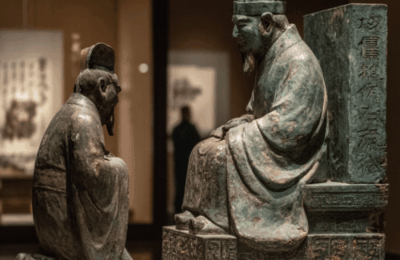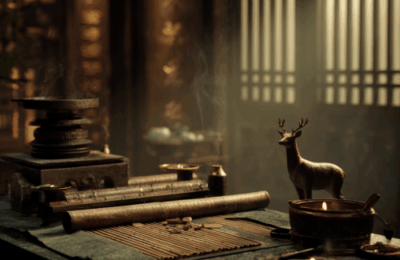在竹简简册与战国楚国政务的条理之间,
我整理出一套成熟而细密的治理逻辑:
清晰的权责分配、风险判断的程序、
以及可以在压力之下保持运作的制度框架。
《五纪》记录时间系统的修复,
《恒先》呈现战略视野的建立,
《王居》书写情绪与权力的自我约束,
《鬼神之明》让信仰与决策接受同一套检验。
这些竹简并不讨论宏观理想,
它们关注“如何让组织在现实条件中持续运作”。
在这里,治理不是宏大理论,
而是一种面对变化时仍能保持判断力的能力。
楚人留下的,是一种可以被现代组织理解、
也可以被个人实践的决策方式。
In the administrative logic of Warring States Chu,
I trace a system built on clarity, procedure and judgment—
a way of handling risk, responsibility and change
that remains intelligible across workplaces and eras.
这一篇记录了楚平王晚年的两场“失败对话”,资料来自上博六《平王与王子木》与《平王问郑寿》。一场发生在田埂之上,一场发生在朝堂之中。太子王子木不识五谷,揭开了教育失根的裂缝;大夫郑寿直言犯上,撞上了王权拒谏的冰墙。两场细微的语言事故,最终在竹简上成为楚国崩塌前的系统日志。This essay records two “failed dialogues” from the late years of King Ping of Chu, drawn from Shanghai Museum Chu Slips VI — Ping Wang and Prince Mu and Ping Wang Questions Zheng Shou. One took place on a field path, the other in the royal court. The crown prince’s inability to recognize a hemp plant exposed a fracture at the root of royal education; Minister Zheng Shou’s frank admonition collided with the icy wall of royal arrogance. These two seemingly minor linguistic incidents were inscribed on bamboo slips as the system log preceding the collapse of Chu.
公元前433年,楚国曾侯乙随葬的240枚竹简—记载车马、甲胄、弓矢与官员职责的精密系统—呈现出战国贵族用文字、编号与命名经营世界的方式。这不是遗物清单,而是一套活着的“王族操作系统”:207匹马的配置、三人一车的模块、楚甲与吴甲的分工、赗赠车马的往来,都在竹简上形成一条清晰的秩序脉络。与墓中震世的编钟青铜相比,这些沉默的竹简展现的是另一种深情——在理性中安放生活,在条理中守护王国。本文带你走入这套系统美学,理解一个战国王族未曾言说的温柔与责任。Dating to 433 BCE, the 240 bamboo slips buried with Marquis Yi of Zeng document not just lists of chariots, armor, and horses—but an entire “royal operating system” built on names, numbers, and protocols. With 207 horses named and assigned, three-man chariot modules configured, Chu and Wu armor categorized, and funerary transport detailed, these slips form a living blueprint of order. In contrast to the tomb’s stunning bronze bells, the bamboo slips whisper a quieter truth: that true nobility lies not only in grandeur, but in the tender logic of caring for a kingdom. This essay explores the system aesthetics behind a Warring States royal’s unspoken devotion.
1994年河南新蔡葛陵楚墓出土楚简一千五百余枚,以楚文字书写卜筮祷辞和谒神祭语,为研究楚国在淮河流域的礼制与信仰提供了珍贵资料。简文记录楚国封君平夜君成的疾病占卜与祈祷,涉及“背膺疾”“逾取禀”等贞问,兼具医卜、军事与祭祀内容。它揭示了楚国贵族在身体、家国与命运之间的纠缠,也呈现出一种以疾病为核心的权力逻辑——身体成为国家的缩影,卜筮成为政治的语言。Unearthed in 1994 from the Chu tomb of Geling in Xincai, Henan Province, more than 1,500 bamboo slips inscribed with Chu script preserve oracular texts and ritual invocations, offering vital evidence of Chu culture in the Huai River region. Among them are records of Lord Pingye’s divinations concerning illness and fate, featuring entries such as “back and chest ailments” and “crossing the border to fetch supplies.” These slips reveal how Chu aristocrats entwined the body with the state and destiny—transforming illness into a political metaphor and divination into the language of power.
《司岁》出自《清华大学藏战国竹简》第十辑,是战国楚系文献中关于时间制度最完整的篇章。它以“岁”为核心,记录岁首行令、祭祀节序与政务节拍,展示楚国如何以天象、节令与行政相互对应,建立自有的时间管理系统。在楚人的思想中,时间不是流逝,而是循环:星辰运转,节气递更,政令复始。这是楚文明的“时间算法”——当时间被立法,文明开始自我运转。Si Sui, included in the tenth volume of the Tsinghua University Collection of Warring States Bamboo Slips, is the most systematic Chu-state text on temporal governance. Centered on the concept of “sui” (the year), it records royal decrees, sacrificial schedules, and administrative rhythms that align politics with the heavens and seasons.
For the Chu people, time was not linear but cyclic—the stars moved, the rites returned, and order renewed itself. This was the time algorithm of Chu civilization: once time became law, the world began to operate on its own rhythm.
上海博物馆藏战国楚竹书于1994年由香港文物市场购入,并经香港收藏人士捐赠入藏,全批约一千七百枚、三万五千余字。竹简以楚系文字书写,内容涵盖儒家、道家、兵家等八十余种先秦古籍。其中的《柬大王泊旱》记录了一位楚王在旱灾与不确定中思考治理的篇章。内容涉及卜筮、水利、政务与德性反思,展现出战国晚期理性与礼制并行的治国智慧。它们不是权力的遗物,而是文明在危机中学习如何抉择与秩序共存的文本。The Shanghai Museum’s collection of Warring States Chu bamboo slips, acquired in 1994 from the Hong Kong antiquities market and later donated by local collectors, contains about 1,700 slips with more than 35,000 characters. Written in the Chu script, they include over eighty pre-Qin texts from the Confucian, Daoist, and military traditions. Among them, King Jian’s Drought Crisis records a Chu ruler’s reflections on governance amid drought and uncertainty—covering divination, hydraulics, statecraft, and moral reasoning. These slips embody the coexistence of reason and ritual in the late Warring States, not relics of power but living documents of how a civilization learned to balance choice and order in times of crisis.
湖北荆门沙洋,一座无战争痕迹的墓室中,出土六百五十余枚竹简。
没有征伐的篇章,只有一位将军的身后记录:祭祷、问病、物品账目——皆以墨书朱印,静静封存。他是楚国大司马悼滑。这些竹简所写的,不是战功,而是一个人在职责、病痛与告别中的生命痕迹。它们不是遗物,而是秩序与人生交织过的证据。In a quiet tomb in Shayang, Jingmen, Hubei, over 650 bamboo slips were unearthed—no tales of war, but the final records of a high-ranking general: ritual petitions, medical inquiries, and personal inventories, inked and sealed in red.
His name was Da Sima Dao Hua. These slips speak not of conquest, but of one man’s final journey through duty, illness, and departure. They are not relics, but the trace of how order and life once intertwined.
从香港文物市场辗转归来的竹简,到今日清华大学修复保存的《清华简》,一座被遗忘的上古档案室重新开启。它们不是沉默的遗物,而是活着的记录——在竹上改写了楚人眼中的周史,也为楚国正名。在这间“上古档案室”里,历史被一片片拼回,记忆也在手指的触碰中复原。From the fragments once circulated through the Hong Kong antiquities market to the restored bamboo slips now preserved at Tsinghua University, the Tsinghua Chu Slips reopen an ancient archive once thought lost. They are not silent relics but living records—rewriting how the Chu people viewed the Zhou world and themselves. In the “Ancient Archive Room,” history is pieced together strip by strip, revealing a civilization’s effort to reclaim its name and its memory.
出土于湖北荆门包山的楚简,既是法的刻痕,也是魂的笔记。白日的楚人用律法维持秩序,夜晚的楚人以卜筮祈求庇佑;理性与神秘在同一根竹上并行,如两条永不交错的铁轨,在时间深处映照出一个文明对秩序的双重信仰。Unearthed at Baoshan in Jingmen, Hubei, the Chu bamboo slips record both the marks of law and the notes of the soul. By day, the people of Chu upheld order through legal codes; by night, they sought protection through divination. Rationality and mystery run side by side on the same bamboo line—two tracks that never cross, yet together reflect a civilization’s enduring faith in order across time.
在楚国中层权力结构中,有一位叫“番胜”的封君,数次走进卜筮间,留下三道令人焦虑的问题——这个月侍奉楚王是否顺利?这场病会不会恶化?新宅能不能长久居住?他不是迷信,而是慎重评估一切变量,进行权力中的高压决策。天星观楚简,记录了一位战国精英的“风险控管日志”,也让我们看见:当年的贵族,就像今天的CEO,也需要一个“解忧事务所”。In the mid-tier power structure of the Chu state, there was a nobleman named Fan Sheng. He stepped into the divination chamber more than once, each time bringing a question shaped by deep anxiety: — Would his service to the King run smoothly this month? — Would his illness worsen, or pass? — Could his new residence truly become a long-term home? This was not superstition. It was a careful evaluation of shifting variables—power-bound decisions made under pressure. The Tianxingguan bamboo slips preserve his “risk management log”, showing us that even in the Warring States era, aristocrats—like today’s CEOs—needed a place to confront uncertainty. A Disquiet Affairs Office, where power meets precaution.









